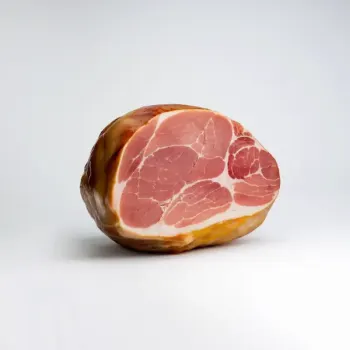Ham and Seitan are protein sources compared for cooking; Ham is from pork, while Seitan is a vegan wheat gluten alternative, each bringing unique flavors and textures to various dishes.

Ham is a cut of pork that comes from the hind leg of the pig. It can be enjoyed fresh, cured, or smoked, and it's known for its rich, savory flavor and tender texture.

Seitan, also known as wheat meat, is a vegan protein source made from hydrated gluten, the main protein in wheat. It has a meaty texture and is versatile in cooking, often used as a meat substitute.
Ham is an animal-based protein with a distinct smoky flavor and can be salty or sweet, depending on the preparation. Seitan is plant-based, has a chewy texture, and its flavor is largely influenced by its seasoning and cooking method.

Your ultimate Recipe Box, Meal Planner, and Cooking Class all in one
In sandwiches, ham adds a smoky, salty punch, best complemented with mustard or cheese. Classic recipes include the Ham and Cheese Sandwich and the Cubano. Seitan can be sliced thin for sandwiches, absorbing flavors like barbecue or teriyaki. It's ideal for vegan versions of Philly Cheesesteaks or Reuben sandwiches.
Ham can be diced into salads for a protein boost, pairing well with greens and vinaigrettes in dishes like Chef's Salad or a Ham and Bean Salad. Seitan can be marinated and grilled for salads, adding a hearty element to dishes like a Seitan Greek Salad or a Warm Seitan and Vegetable Salad.
Ham brings a savory depth to stir-fries, particularly in Asian cuisine, such as in Fried Rice or Ham and Vegetable Stir-Fry. Seitan absorbs stir-fry sauces well and maintains its texture, making it suitable for dishes like Kung Pao Seitan or Vegan Stir-Fry with Seitan and Broccoli.
Ham is often a centerpiece in holiday meals, with recipes like Glazed Ham or Ham with Pineapple and Cherries. Seitan can be prepared as a festive roast, seasoned with herbs and spices, serving as a vegan alternative in dishes like Seitan Holiday Roast or Vegan Wellington.
Ham is high in protein but also contains cholesterol and a higher amount of sodium. Seitan is a low-fat, cholesterol-free protein source that is high in selenium.
| Nutrient | Ham ( per 100g ) | Seitan ( per 100g ) |
|---|---|---|
| Fat | 5g | 1.9g |
| Sodium | 1040mg | 600mg |
| Protein | 24g | 75g |
| Calories | 145 | 370 |
| Cholesterol | 60mg | 0mg |
| Carbohydrates | 1.5g | 14g |
Seitan is a healthy alternative for those seeking a high-protein, low-fat option; however, it lacks certain nutrients found in ham, such as B vitamins.
Seitan does not naturally have the same flavor as ham, so you'll need to season it accordingly. It can, however, provide a similar texture.
Marinate seitan in a blend of smoky and savory seasonings, such as liquid smoke, soy sauce, and maple syrup, to better emulate the flavor of ham.
No, ham is not suitable for a vegetarian diet as it is an animal-based product.
Yes, seitan is made from wheat gluten, which is unsuitable for those with celiac disease or a gluten intolerance.